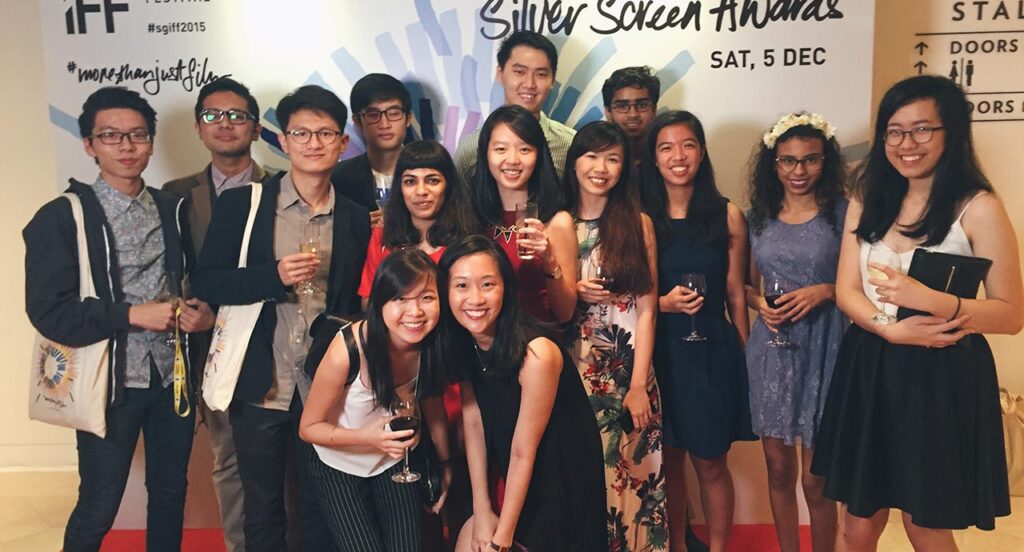Reflections on the Youth Jury and Critics Programme 2015


Six weeks ago, if you were to ask me what a jury at a film festival does, I would have pictured a panel of distinguished judges – somehow they were always old, ang moh men in my head – quietly hunched around a table in a secret location. It’s the stuff of classic spy movies. Gathered around a flickering light source, they would trade remarks in hushed whispers, carefully write their votes on tiny pieces of paper and, finally, take turns to drop them in a mysterious black box.
But fast-forward to today, after rubbing shoulders with experienced film reviewers, industry experts, and filmmakers, I have come to realize that being a member of jury or a film critic is not just about choosing your favourite film in the shortlist.
We did not just gather in a circle, exchange quick words, and readily come to an agreement.
Before the 15 of us in the Youth Jury & Critics Programme had to decide the winning film for the Youth Jury Prize, we had to first put in place some standards for consideration to guide our decision-making process. It was a bit like coming up with a value proposition or a mission statement for a small company. What does it mean to be Southeast Asian? What is the agenda being put forth in our final decision? What do we want to see more from the filmmaker?
It was a methodical, tedious and extremely difficult procedure. All of us had our personal favourites, and it was difficult to narrow our options down to a single film because we each had different standards, with which we qualify our preference for a film.
But it was by no means a dull, clinical process.
While we did not spit curses or shake our fists of fury towards the sky (although, I think, some of us very nearly did), we argued hotly with well-reasoned explanations; we had no qualms challenging other opinions with alternative perspectives and we were unafraid to stand by our viewpoints even whilst being “attacked”.
It was exhilarating, stimulating, and most importantly, fun.
And, in a way, I think this is a reflection of how a film industry should work.
Aptly, this year’s SGIFF theme, “More than just Film”, harkens back to the need for a diversity of voices to contribute to an open discussion. It is an organic process: filmmakers, film lovers and critics are part of an elaborate network that can contribute to a healthy discourse, which will lead to better films, more feedback, and a greater appreciation for future works.
Having just one or two mainstream voices reflecting on a film may trickle down to a few polarizing viewpoints, or form a homogenous opinion based upon a small sample size, which will eventually lead to a dilution of ideas that cannot sufficiently stimulate a healthy discourse.
In the long run, filmmakers may become uncomfortable about receiving criticism or listening to a new, alternative voice, and this can be detrimental to the growth of the industry.
But having many voices in the discussion will create a natural marketplace of ideas, which will regulate counterargument and can be streamlined into a series of constructive feedback for the filmmaker to improve upon his or her craft. Film critics can also get a glimpse of different perspectives, choose to align themselves with ideas that are congruent to their feelings about a film, and contribute to the conversation.
I especially felt the importance of a multidirectional conversation during the opportunity to speak with filmmakers before and after the Silver Screen Awards. Viewers and critics alike may draw different meanings that were not originally intended in certain films, or miss certain cues that were premeditated.
Take for example: the ending scene of “The Day The Sky Roared, during which the little girl, dressed in an astronaut suit, is depicted gazing up towards the sky with a childlike wonder.
My initial reading of the scene was that the little girl, who is a symbol of innocence and purity, is seeking comfort in her fantastical imagination about space travel. Sheltered from the tragedy of the Jakarta riots, she gazes at the sky to highlight her unadulterated hope for the future.
After speaking to the producers for this SEA short, we learnt that the ending scene had another hidden layer: the little girl, who daydreams about space travel, is also an alien in her own home. Being an ethnic minority in Indonesia, the intention of the ending scene was to underscore her vulnerability as a young Indonesian Chinese girl. “She is both an alien in her own home, as she would have been on another planet,” the producers tell us.
While it doesn’t mean that we should always be able to pick up on these intended cues, this experience does highlight the importance of having a conversation, and being open to different interpretations to a film.
Being a film critic is more than just writing about films or awarding them with stars in our reviews. We champion good works, but we must also be willing to provide honest feedback, which may divert from the majority opinion. It isn’t about being an oppositional voice, as some may choose to believe. It is about offering an alternative voice that will ultimately lead to more polished films.
It has been a privilege to learn from the experience of industry professionals, speak to talented filmmakers, and contribute to the growing film scene in Southeast Asia.
More significantly, it has been such a humbling and inspiring experience working alongside other young film lovers and budding critical writers. The YJCP 2015 team certainly hopes that more voices will join in the chorus of film discussion in the years to come!


